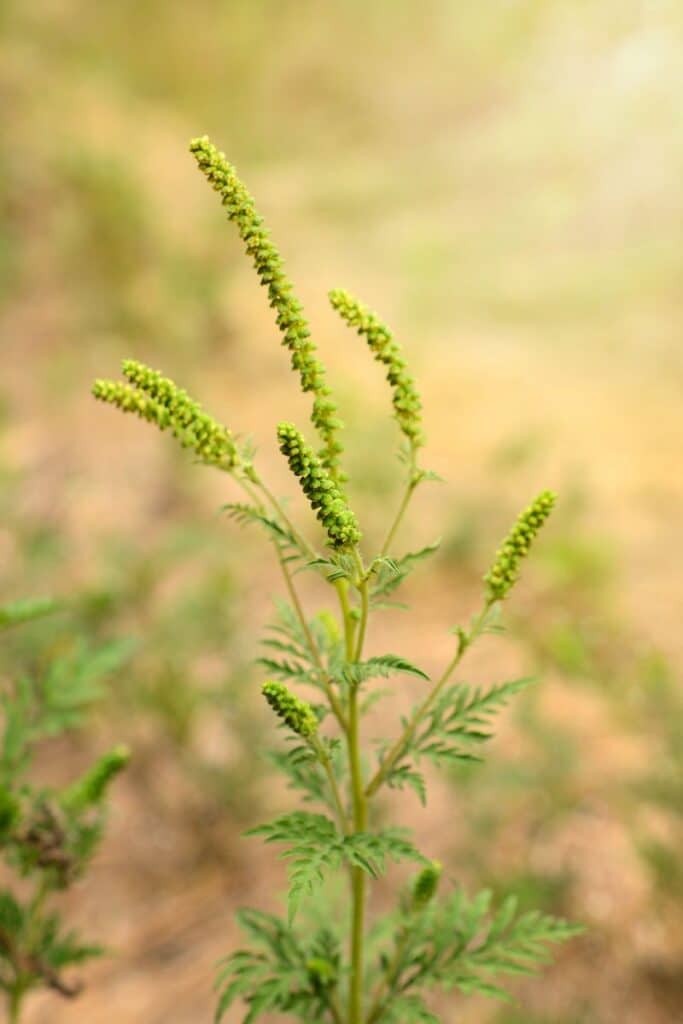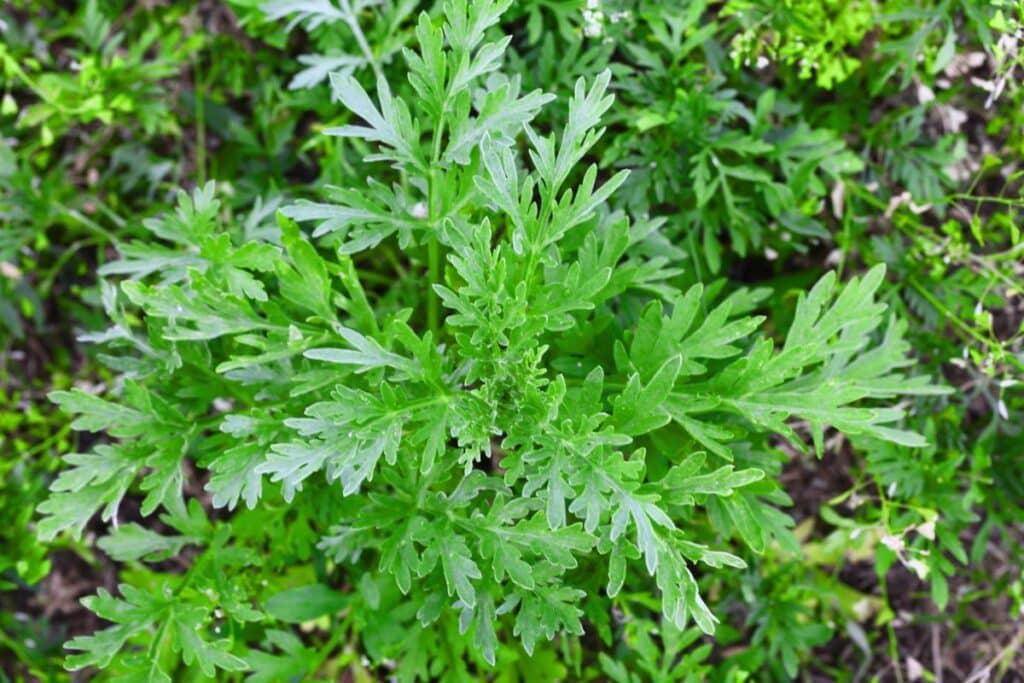If you suffer from seasonal allergies, chances are you’re all too familiar with the misery that ragweed can cause. Ragweed is a type of weed that grows wild in many parts of the United States.
It’s also a leading cause of allergy symptoms such as sneezing, runny nose, and itchy eyes – even compared to other allergens, like tree pollen, a ragweed allergy is perhaps the most common culprit behind most seasonal allergies.
In this post, we’ll give you some tips on how to identify ragweed. Whether you’re an allergy sufferer looking to avoid this plant or are just curious, you’ll find everything you need to know here!
Common Types of Ragweed Flowers
Ragweed is a common allergen that affects millions of people in the United States. There are actually several different types of ragweed plants, each of which can trigger allergic reactions in sensitive people.
The first type of ragweed plant is annual ragweed (Ambrosia artemisiifolia). As its name suggests, annual ragweed only lives for one growing season. It typically germinates in late spring or early summer and then dies off in the fall once it has produced its pollen.
Annual ragweed plants are small, usually only reaching heights of 18 inches. They have green, deeply lobed leaves and produce inconspicuous flowers that are borne on small, spiked clusters.
The second type of ragweed plant is common ragweed (Ambrosia trifida). Common ragweed is actually a perennial plant, meaning that it can live for several years. Common ragweed flowers typically bloom from August to October and can reach heights of 12 feet or more.
The common ragweed leaf, with its fern-like appearance, is made up of multiple leaflets. These leaflets are roughly 6 inches long and 4 inches across.
Common ragweed plants have large, triangular leaves and produce greenish-white flowers that are borne in small, spike-like clusters.
Common ragweed seeds spread easily. Pollen from the common ragweed plant is perhaps the most notorious for causing allergic reactions in susceptible people. If you notice this type of plant on your property, you need to take steps to control ragweed growth ASAP to prevent yourself from getting sick from the ragweed flowers.
The third and final type of ragweed plant is giant Ragweed (Ambrosia gigantean). As its name suggests, giant ragweed is the largest type of ragweed plant, often reaching heights of 20 feet or more.
Giant ragweed starts blooming from July to September and produces large clusters of yellowish-green flowers. Giant ragweed plants have large, lobed leaves and their stems are covered in coarse hairs.

What Does Ragweed Look Like?
Ragweed plants are annuals that can grow to be over two feet tall.
Ragweed is a flowering plant that belongs to the Asteraceae family. This family also includes other plants such as daisies, chrysanthemums, and marigolds. Ragweed pollen is very lightweight and can be transported by the wind over long distances. That’s why it’s so difficult to avoid if you’re allergic to it.
The leaves of ragweed plants are lance-shaped and have serrated edges. The leaves of ragweed plants are green, but they may turn red or purple as the plant begins to flower.
Ragweed flowers are small and green, and they grow in clusters at the tips of the plant’s stems. After the flowers bloom, ragweed plants produce fruits that contain seeds. These seeds are dispersed by the wind and can travel long distances.
Ragweed pollen is produced by the male flowers of the plant. Pollen production begins in mid-July and continues through September or October. Pollen levels are usually highest in the morning hours and on warm, dry days.
The female flowers, which are even easier to overlook than the male flowers, are hidden in the upper leaf axils—the angles between the upper side of a leaf or stem and the supporting stem or branch. These female flowers are succeeded by fruits that are technically designated as “achene,” which are small, dry, single-seed fruits.
Wind speeds of just 10 miles per hour can cause ragweed pollen to disperse over large areas. When pollen levels are high, it is important for people with ragweed allergies to stay indoors as much as possible and to avoid being outdoors during peak pollen hours.
What Does Young Ragweed Look Like?
The best way to identify a young ragweed plant is by its leaves. Ragweed leaves are green and have a rough texture. They’re arranged alternately on the stem and have serrated edges. The leaves are small, usually only 1-2 inches long, and they have a noticeable V-shaped notch at the base.
What Does Ragweed Look Like in Spring?
Ragweed is a common allergen that can cause symptoms like sneezing, sniffling, and itchy eyes. The plant typically blooms in the late summer and fall, releasing pollen into the air that can trigger allergies. But what is ragweed identification in the spring?
In the spring, ragweed plants are small and inconspicuous, with just a few leaves. The leaves are green and lance-shaped, and they grow in pairs on opposite sides of the stem.
By late May or early June, the plants begin to produce flowers. The flowers are small and green, with no petals. They grow in clusters at the ends of the stems.
Once the flowers bloom, the plants quickly mature and produce seeds. Ragweed seeds can remain viable for up to 10 years, meaning that a single plant can produce pollen for many seasons.
So if you’re allergic to ragweed, be sure to keep an eye out for these plants in the springtime. And if you see them growing near your home, you may want to consider taking steps to remove them before they have a chance to release their pollen into the air.

What Does Ragweed Look Like Before it Blooms?
Before ragweed blooms, it looks like a small, unassuming plant. The leaves are green and oval-shaped, and the stem is thin and spindly. However, ragweed is actually a member of the aster family, and it produces small, yellow flowers that can cause hay fever in susceptible people.
Ragweed plants are common in North America, and they typically bloom from August to October. During this time, pollen from the flowers can be carried by the wind for miles, causing allergies even in people who have never been near a ragweed plant.
What Does Ragweed Pollen Look Like?
Each year, ragweed plants release billions of tiny grains of pollen into the air. These pollen grains are lightweight and can be carried long distances by the wind. When they come into contact with mucous membranes, they can cause an allergic reaction.
Ragweed pollen is typically yellowish-green in color and is relatively large, measuring 10-30 microns in diameter. It is often visible to the naked eye, particularly on clothing or surfaces that have been exposed to the outdoors.
For people with ragweed allergies, avoiding contact with pollen is the best way to prevent symptoms. This means staying inside on days when pollen levels are high and taking steps to remove pollen from clothing and skin after spending time outdoors. Some people with ragweed allergies may also benefit from taking medication or receiving allergy shots.
What Does Ragweed Look Like When It’s In Bloom?
Ragweed plants can vary in size, but they typically grow to be about two or three feet tall. The leaves of ragweed plants are usually divided into two or three smaller leaflets.
There are several species of ragweed, but they all have similar-looking flowers. The leaves of ragweed plants are usually green, but they can also be red or purple. The flowers are small and insignificant-looking, but they pack a powerful punch when it comes to producing pollen.
Each flower only produces a tiny amount of pollen, but ragweed plants can produce billions of grains of pollen per season!
What Does Ragweed Look Like in the Fall?
Ragweed blooms from August to November, with peak bloom occurring in mid-September. During this time, the plant produces small, greenish-white flowers. These flowers are clustered together at the ends of the stems.
During this season, ragweed plants are usually between 1 and 2 feet tall, and they have small, green leaves. The leaves are attached to the stem at a point, rather than along the edges like most other plants.
Once the flowers bloom, they release pollen into the air. Ragweed pollen is very light and can travel long distances on the wind. Just one ragweed plant can produce up to 1 billion pollen grains!
What Does Ragweed Look Like When it Has Died Back?
Ragweed season typically runs from mid-August through the end of September—or sometimes even into October—but the plant starts to die back once the pollen has been released. The death of ragweed is actually a gradual process.
First, the leaves on the lower part of the plant will turn yellow and brown and begin to wither away. Next, the leaves on the upper part of the plant will follow suit, turning yellow and brown before eventually falling off.
Finally, the stem of the plant will turn brown and dry up, leaving nothing behind but a hollow stalk.
Where is Ragweed Most Commonly Found?
Ragweed is most commonly found in rural areas, particularly in fields where crops are grown. However, it can also be found in urban areas, especially in vacant lots or along roadsides. Ragweed is also frequently found in parks and other green spaces.
How Do You Tell the Difference Between Ragweed and Goldenrod?
The battle of the allergens! Ragweed and goldenrod are two plants that often get lumped together because they are both allergens. However, they are actually quite different from each other!
Here’s a quick guide to help you tell the difference between ragweed and goldenrod.
Ragweed:
- Usually blooms in August/September
- Has small, green flowers
- Pollen is light and airy, so it can travel long distances on the wind
- Found in fields, vacant lots, and roadside ditches
- Can cause sneezing, runny nose, congestion, and itchy eyes
Goldenrod:
- Usually blooms in late summer/early fall
- Has small, yellow flowers
- Pollen is heavier than ragweed pollen so it doesn’t travel as far on the wind
- Found in open woods, meadows, and along roadsides
- Can cause sneezing, runny nose, and congestion (but less likely to be an allergy than ragweed)
FAQs
What is mistaken for ragweed?
Plants that are sometimes mistaken for ragweed include goldenrod and common yarrow. Although these plants have a similar appearance, they belong to different plant families and do not typically cause the same allergic reactions.
What are symptoms of ragweed allergy?
Symptoms of ragweed allergy can include sneezing, runny or stuffy nose, itchy or watery eyes, sore throat, and coughing. Some people may also experience skin rashes, headaches, or fatigue.
What is another name for ragweed?
Another name for ragweed is Ambrosia. There are several species of ragweed within the genus Ambrosia, including common ragweed (Ambrosia artemisiifolia) and giant ragweed (Ambrosia trifida).
How do you get rid of ragweed?
To get rid of ragweed, it’s important to remove the plants before they flower and produce pollen. You can do this by mowing, pulling, or digging up the plants. Keep your lawn or garden well-maintained to prevent ragweed from establishing. Applying a pre-emergent herbicide in early spring can also help prevent ragweed seeds from germinating.
Final Thoughts
Whether you’re one of the millions of allergy sufferers who wants to know how to identify this tall weed to prevent an all-out attack on your immune system, or you just want to get rid of the weeds that might be growing in your garden, it’s important to understand what ragweed looks like.
While leaves and flowers on the common ragweed plant might look different than giant ragweed flowers (and of course, annual ragweed as well!)Understanding common characteristics of ragweed can help you stay healthy – and happy – all year long.
See more: What Does Goldenrod Look Like?
*image by kolesnikovserg&sssss1gmel/depositphotos






